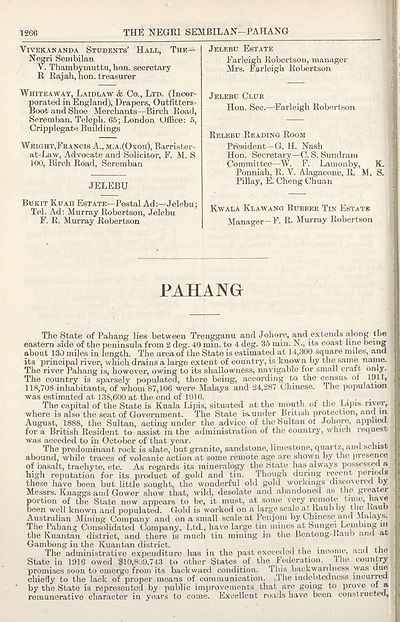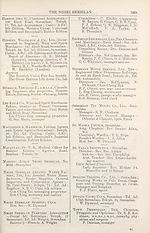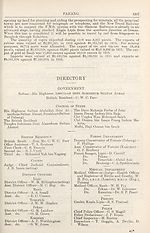1918
(1346) Page 1266 - Pahang
Download files
Complete book:
Individual page:
Thumbnail gallery: Grid view | List view

THE NEGRI SEMBILAN—PAHANG
VlVEKANANDA STUDENTS’ HALL, THE—
Negri Senibilan
V. Thambymuttu, hon. secretary
R Rajah, lion, treasurer
Whiteaway, LAidlaw & Co., Ltd. (Incor¬
porated in England), Drapers, Outfitters-
Boot and Shoe Merchants—Birch Road,
Seremban. Teleph. 65; London Office: 5,
Cripplegate Buildings
Wright,Frakcis A., M.A.(Oxori), Barrister-
at-Law, Advocate and Solicitor, F. M. S
100, Birch Road, Seremban
JELEBU
Bukit Kuah Estate—Postal Ad:—Jelebu;
Tel. Ad: Murray Robertson, Jelebu
F. R. Murray Robertson
Jelebu Estate
Farleigh Robertson, manager
Mrs. Farleigh Robertson
Jelebu Club
Hon. Sec.—Farleigh Robertson
Relebu Reading Room
President—G. H. Nash
Hon. Secretary—C. S. Sundram
Committee—W. F. Lamonby, K.
Ponniah, R. V. Alagacone, R. M. S.
Pillay, E. Cheng Chuan
Kwala Klawang Rubber Tin Estate
Manager-F. R. Murray Robertson
PAHANG
The State of Pahang lies between Trengganu and Johore, and extends along the
eastern side of the peninsula from 2 deg. 40 min. to 4 deg. 35 min. N., its coast line being
about 130 miles in length. The area of the State is estimated at 14,300 square miles, and
its principal river, which drains a large extent of country, is known by the same name.
The river Pahang is, however, owing to its shallowness, navigable for small craft only.
The country is sparsely populated, there being, according to the census oi 1911,
118,708 inhabitants, of whom 87,106 were Malays and 24,287 Chinese. The population
was estimated at 138,600 at the end of 1916. . .
The capital of the State is Kuala Lipis, situated at the mouth oi the Lipis nvei',
where is also the seat of Government. The State is. under British protection, and m
August, 1888, the Sultan, acting under the advice of the Sultan of Johore, appiied
for a British Resident to assist in the administration of the country, which request
was acceded to in October of that year. ,
The predominant rock is slate, but granite, sandstone, limestone, quartz, and schist
abound, while traces of volcanic action at some remote age are shown by the presence
of basalt, trachyte, etc. As regards its mineralogy the State has always possessed a
high reputation for its product of gold and tin. Though during recent periods
these have been but little sought, the wonderful old gold workings discovered by
Messrs. Knaggs and Gower show that, wild, desolate and abandoned as the greater
portion of the State now appears to be, it must, at some very remote time, have
been well known and populated. Gold is worked on a large scale at Raub by the iiaiib
Australian Mining Company and on a small scale at Penjom by Chinese and Malays.
The Pahang Consolidated Company, Ltd., have large tin mines at Sungei Lembing in
the Kuantan district, and there is much tin mining in the Bentong-Laub and at
Gambong in the Kuantan district. . , ,
The administrative expenditure has in the past exceeded the income, and the
State in 1916 owed $10,8u9,743 to other States of the Federation, the country
promises soon to emerge from its backward condition. This backwardness was due
chiefly to the lack of proper means of communication. ;The indebtedness incurred
by the State is represented by public improvements that are going to prove ol a
remunerative character in years to come. Excellent roads have been constructed.
VlVEKANANDA STUDENTS’ HALL, THE—
Negri Senibilan
V. Thambymuttu, hon. secretary
R Rajah, lion, treasurer
Whiteaway, LAidlaw & Co., Ltd. (Incor¬
porated in England), Drapers, Outfitters-
Boot and Shoe Merchants—Birch Road,
Seremban. Teleph. 65; London Office: 5,
Cripplegate Buildings
Wright,Frakcis A., M.A.(Oxori), Barrister-
at-Law, Advocate and Solicitor, F. M. S
100, Birch Road, Seremban
JELEBU
Bukit Kuah Estate—Postal Ad:—Jelebu;
Tel. Ad: Murray Robertson, Jelebu
F. R. Murray Robertson
Jelebu Estate
Farleigh Robertson, manager
Mrs. Farleigh Robertson
Jelebu Club
Hon. Sec.—Farleigh Robertson
Relebu Reading Room
President—G. H. Nash
Hon. Secretary—C. S. Sundram
Committee—W. F. Lamonby, K.
Ponniah, R. V. Alagacone, R. M. S.
Pillay, E. Cheng Chuan
Kwala Klawang Rubber Tin Estate
Manager-F. R. Murray Robertson
PAHANG
The State of Pahang lies between Trengganu and Johore, and extends along the
eastern side of the peninsula from 2 deg. 40 min. to 4 deg. 35 min. N., its coast line being
about 130 miles in length. The area of the State is estimated at 14,300 square miles, and
its principal river, which drains a large extent of country, is known by the same name.
The river Pahang is, however, owing to its shallowness, navigable for small craft only.
The country is sparsely populated, there being, according to the census oi 1911,
118,708 inhabitants, of whom 87,106 were Malays and 24,287 Chinese. The population
was estimated at 138,600 at the end of 1916. . .
The capital of the State is Kuala Lipis, situated at the mouth oi the Lipis nvei',
where is also the seat of Government. The State is. under British protection, and m
August, 1888, the Sultan, acting under the advice of the Sultan of Johore, appiied
for a British Resident to assist in the administration of the country, which request
was acceded to in October of that year. ,
The predominant rock is slate, but granite, sandstone, limestone, quartz, and schist
abound, while traces of volcanic action at some remote age are shown by the presence
of basalt, trachyte, etc. As regards its mineralogy the State has always possessed a
high reputation for its product of gold and tin. Though during recent periods
these have been but little sought, the wonderful old gold workings discovered by
Messrs. Knaggs and Gower show that, wild, desolate and abandoned as the greater
portion of the State now appears to be, it must, at some very remote time, have
been well known and populated. Gold is worked on a large scale at Raub by the iiaiib
Australian Mining Company and on a small scale at Penjom by Chinese and Malays.
The Pahang Consolidated Company, Ltd., have large tin mines at Sungei Lembing in
the Kuantan district, and there is much tin mining in the Bentong-Laub and at
Gambong in the Kuantan district. . , ,
The administrative expenditure has in the past exceeded the income, and the
State in 1916 owed $10,8u9,743 to other States of the Federation, the country
promises soon to emerge from its backward condition. This backwardness was due
chiefly to the lack of proper means of communication. ;The indebtedness incurred
by the State is represented by public improvements that are going to prove ol a
remunerative character in years to come. Excellent roads have been constructed.
Set display mode to:
![]() Universal Viewer |
Universal Viewer | ![]() Mirador |
Large image | Transcription
Mirador |
Large image | Transcription
Images and transcriptions on this page, including medium image downloads, may be used under the Creative Commons Attribution 4.0 International Licence unless otherwise stated. ![]()
| Asian directories and chronicles > 1918 > (1346) Page 1266 - Pahang |
|---|
| Permanent URL | https://digital.nls.uk/194910828 |
|---|
| Attribution and copyright: |
|
|---|---|
| Description | Volumes from the Asian 'Directory and Chronicle' series covering 1917-1941, but missing 1919 and 1923. Compiled annually from a multiplicity of local sources and research. They provide listings of each country's active corporations, foreign residents and government agencies of all nationalities for that year, together with their addresses. Content includes: various treaties; coverage of conflicts; currencies and taxes; consular fees; weights and measures; public holidays; festivals and traditions. A source of information for both Western states and communities of foreigners living in Asia. Published by Hongkong Daily Press. |
|---|---|
| Shelfmark | H3.86.1303 |
| Additional NLS resources: |

